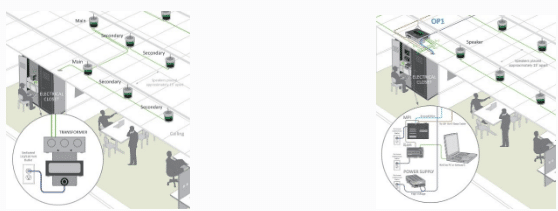Why sound masking?
Sound masking also known as “White Noise” or “Pink Noise” is the only acoustical treatment that addresses all sound paths. The acoustical effect of walls, carpets and ceilings are static; sound masking can be tuned and adjusted as needed. Adding sound masking to an open office space is the acoustical equivalent of tripling the distance between workers! The difference between Pink and White noise is White noise is a sound that has equal energy on every frequency. Pink noise is equal energy per octave, rather that equal energy per frequency. What this means to you is that Pink noise is effective for creating speech privacy and is more comfortable to listen to in an office environment.
Who Needs Sound Masking?
- Almost everyone. If you’ve ever been interrupted by your co-workers’ conversations, been overly aware that other people can hear your conversation or been distracted by ringing telephones, printers and other machines, you’re a prime candidate for the benefits of sound masking.
- Privacy and noise are big issues in open offices. In addition, in healthcare and related service fields, protecting sensitive patient information is not just a top priority, it is the law. The potential for oral disclosure is seen by some to be the most serious of all the risks.
- The good news: installing a sound masking system is a cost-effective solution.
What are the benefits?
Sound masking systems reduce conversational distractions while increasing worker concentration, productivity, accuracy and satisfaction. Today’s green buildings introduce new acoustical challenges. Adding sound masking can help solve the lack of privacy caused by decreasing workstation heights and less room absorption.
How does sound masking work?
The premise behind this solution is simple: any noises that are below the new background level created by the masking sound are covered up and the impact of those still above it is lessened because the degree of change between baseline and peak volumes is smaller. Similarly, conversations are either entirely masked or their intelligibility is reduced, improving occupants’ privacy and decreasing the number of disruptions to their concentration.
Most people have experienced this effect when running water at their kitchen sink while trying to talk to someone in the next room. They can tell the other person is speaking, but it’s difficult to comprehend what they’re saying because the running water has raised the background sound level in their area. Examples are, in fact, endless: the sound of an airplane engine, rustling leaves, the murmur of a crowd in a busy restaurant. All have the potential to mask sounds you would otherwise hear.
Of course, when introducing a masking sound to your workplace, it’s vital to ensure that it’s as comfortable and unobtrusive as possible.
Where Do I Put Soundmasking?
Sound Masking goes where you don’t want speech to be overheard (over the recipient). For example if you don’t want people in reception to overhear what is being spoken in the conference room, you would put the sound masking outside the conference room over the people in reception. If you put it in the conference room it would make it so the people within the conference room would no longer be disturbed but the employees outside would still understand them. It is easy to remember as sound masking goes “where the ears are”. Sound masking can be very effective in open plan environments, private offices, call centers, corporate environments, law firms, healthcare environments, financial institutions, government facilities, military facilities and anywhere speech privacy is required.
Some valuable information on acoustical privacy for open and closed offices can be found by going to the following links on one of Taylored Systems vendors for Soundmasking:
- The first being a closed office environment
- The second being the open office environment
Soundmasking in the Healthcare Industry and HIPAA Compliance

The soundmasking products we sell at Taylored Systems meets ASTM standards for speech privacy, and Taylored Systems has installed systems at dozens of healthcare clients, including:
- Billing Agencies
- Employers
- Hospitals
- Information Systems Vendors
- Life Insurers
- Medical Clinics
- Military Medical Bases
- Pharmacies
- Physician Offices
- Public Health Authorities
- Service Organizations
- Universities
For details about how sound masking is used to meet HIPAA requirements, follow this link to one of our manufacturers Lencore, and their Guide to HIPAA Oral Privacy.
Here at Taylored Systems we have been selling, installing and servicing soundmasking systems since 2006. We have installed them in large open space office suites containing cubicles. We have also done several medical facilities where we place the masking units in the exam rooms as well as the hallways and around the reception desk and nurse’s station. Soundmasking can be used in almost any business. We are dealers for Lencore, and Dynasound. Contact your Taylored Systems Representative for and appointment to come out and evaluate your business for soundmasking today. Visit our web page at www.taylored.com.

